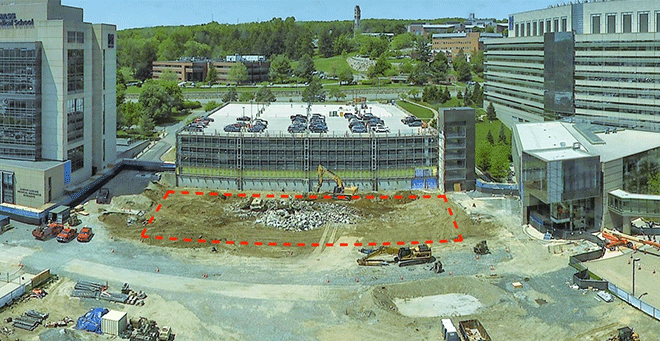Construction of the new education and research building on the UMass Medical School main campus in Worcester goes underground this week, as crews begin excavation for the foundation of the structure.

The nine-story, 350,000-square-foot building requires a massive concrete foundation, set on bedrock approximately 38 feet below the surface.
“All the work done so far was to prepare the site for construction of the new building,” said John Baker, associate vice chancellor for facilities management. “We’re entering a new phase of this project, and over the next few months people will see a lot of excavation, more truck traffic coming on and off the site, and eventually some blasting of the bedrock.”
The building will be located between the Albert Sherman Center and the Lazare Research Building, on land made available by the recent demolition of a portion of the First Road garage. Also, during the site preparatory phase, underground utility lines were relocated to clear the area for excavation.
Crews are digging the foundation hole in the area outlined in red on the site photo. An estimated 60 to 80 truckloads of soil and rock will be hauled off the site daily. All trucks will access the site via South Road from Plantation Street.
UMass Medical School Public Safety will be stationed at the intersection of South Road and the construction site access road from 7 a.m. to 3 p.m. on weekdays to monitor the flow of pedestrian and vehicle traffic.
Given the proximity of other buildings, and the depth of the hole, temporary retaining walls will be installed to stabilize the perimeter of the excavation as workers dig deep.
Two types of retaining walls will be used. Along the south side of the hole, closest to the LRB, steel piles will be drilled into the soil and anchored in the bedrock. Wooden beams will be installed horizontally between the steel piles to form the wall.
In other areas of the site, a “soil nailing” system will be used. In this technique, sections of steel mesh are rolled across the exposed soil. Concrete is then sprayed onto the mesh to form a solid wall. An array of steel rods, some 20 feet long, are driven into the side of the hardened concrete and fixed in place with concrete grout.
Installing the retaining walls and excavating the soil will be done in parallel. As the excavation crew digs away soil, the retaining walls will be extended lower. When the excavation reaches bedrock, blasting will be required to fracture the rock so it can be hauled away.
Blasting is expected to begin in mid-June. A detailed blasting plan has been submitted and is now under review. “There was a lot of blasting required when the Sherman Center was built, so we understand how to manage and monitor the activity,” Baker said. “We will be communicating the details of the plan to the whole community several weeks before the first test blast, so people understand the process and can be prepared.”
Excavation is expected to take at least six months. During that time, several measures will limit the impact on campus, including air quality monitoring and regular spraying of water on the site to reduce dust. A tire cleaning process will be in place to remove debris from trucks leaving the site.
Vibration monitors installed in the surrounding buildings have been measuring baseline vibration for several months. Any significant increase in vibration caused by construction will be evaluated and activity adjusted.
The new building will have research space for a projected 77 principal investigators and other educational uses. It is slated to open late in 2023. For more information on the project visit https://www.umassmed.edu/NERB/